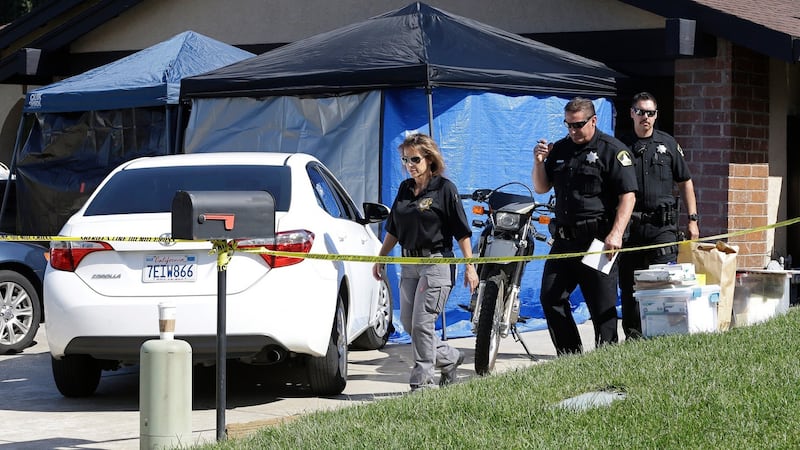The Golden State killer raped and killed victims all across the state of California in an era before Google searches and social media, a time when police relied on shoe leather, not mobile phone records or big data. But it was technology that finally made a breakthrough.
The suspect, Joseph James DeAngelo (72), was arrested by police on Tuesday. Investigators accuse him of committing more than 50 rapes and 12 murders. Investigators used DNA from crime scenes that had been stored all these years and plugged the genetic profile of the suspected assailant into an online genealogy database. They found distant relatives of DeAngelo’s and, despite his years of eluding authorities, traced their DNA to his front door.
"We found a person that was the right age and lived in this area – and that was DeAngelo," said Steve Grippi, the assistant chief in the Sacramento district attorney's office. Investigators then obtained what Anne Marie Schubert, the Sacramento district attorney, called "abandoned" DNA samples from DeAngelo. "You leave your DNA in a place that is a public domain," she said.
The test result confirmed the match to more than 10 murders in California. Schubert’s office then obtained a second sample and came back with the same positive result, matching the full DNA profile. Those who had investigated the case for years in vain were ecstatic by the sudden breakthrough.
"He was totally off the radar till just a week ago, and it was a lead they got, somehow they got information and through checking family or descendants – it was pretty complicated the way they did it – they were able to get him on the radar," said Ray Biondi (81), who was the lieutenant in charge of the homicide bureau of the Sacramento County sheriff's department during the crime spree.
Representatives at 23andMe and other gene testing services denied on Thursday that they had been involved in identifying the killer. The big players in commercial DNA testing – including 23andMe and AncestryDNA – extract genetic profiles from the saliva that customers send to the company in a tube by mail. It would not be easy for law enforcement to upload a profile to one of those sites.

During the past few years, numerous smaller genealogical websites have emerged, however, giving customers more avenues to upload a DNA profile and search for relatives.
If law enforcement located the suspect through a genealogy site, it could raise ethical issues, particularly if individuals did not consent to having their genetic profiles searched against crime scene evidence.
Sadistic rituals
The Golden State killer, also known as the East Area Rapist, tormented his victims with sadistic rituals. Some he shot and killed with a firearm. Others were bludgeoned to death with whatever he could find – in one case a piece of firewood. He had many trademarks: He wore a mask, he bound his victims’ hands. He started by raping single women and then went on to raping married women with their husbands present, before killing them both.
Among the numerous serial killers who stalked America in the 1960s, 1970s and 1980s – the Zodiac Killer, the Son of Sam, to name two – the Golden State killer was among the most notorious. Schubert has been central to the efforts to find the killer. Her childhood in the Sacramento suburb of Arden-Arcade, just miles from where the suspect prowled through houses and raped women, was marked by the terror of wondering if she or people she knew might be next.
“It wasn’t a matter of if he was coming, it was when,” Schubert said. Her parents were “not gun people”, she said, but her father bought a firearm. Her mother kept an ice pick under her pillow when she slept.
Monica Miller, who was in charge of the Sacramento FBI field office from 2013-17, said that when she retired, the case of the Golden State killer was cold. She said that Schubert, "was central in leading this, convincing people this was worth pursuing". "For the people of Sacramento," she added, "it was almost an open wound. People would still talk about it. He was a phantom or a ghost in people's minds."
In her career as a district attorney, Schubert championed DNA technology and taught courses about cold cases, creating a unit in the Sacramento district attorney's office to pursue them. Eighteen years ago, she reached out to an investigator from Contra Costa County who specialised in the East Area Rapist, beginning a collaboration to re-energise the case.
Two years ago, she convened a task force on the 40th anniversary of the attacks in the Sacramento suburbs. It was the work of that group – a collaboration with counties in southern California, the San Francisco Bay Area and the FBI – that helped solve the case, Schubert said.
Remaining questions
Many questions remain about the suspect. Did his family or his former colleagues have hints about his grisly past? Why did he appear to stop his spree of rapes and murders in 1986? Did he leverage his job as a police officer to elude detection?
All of these questions swirled in conversations among residents of Citrus Heights, California. Paul Sanchietti, a neighbour, said he had taken an interest in the case six months ago and combed through the Wikipedia entry that listed all of the grisly and sadistic crimes the Golden State killer was accused of committing.
Sanchietti said he had nothing more than polite interactions with DeAngelo over the past two decades, but like other neighbours, he remembered DeAngelo as having a temper. “He would get volatile,” Sanchietti said. “He would be out here tending to his car, and he would get very angry. There were a lot of four letter words.”
“Every neighbourhood has some strange little dude,” Sanchietti said. “But for him to be a serial murderer and rapist – that never crossed my mind.” – New York Times











